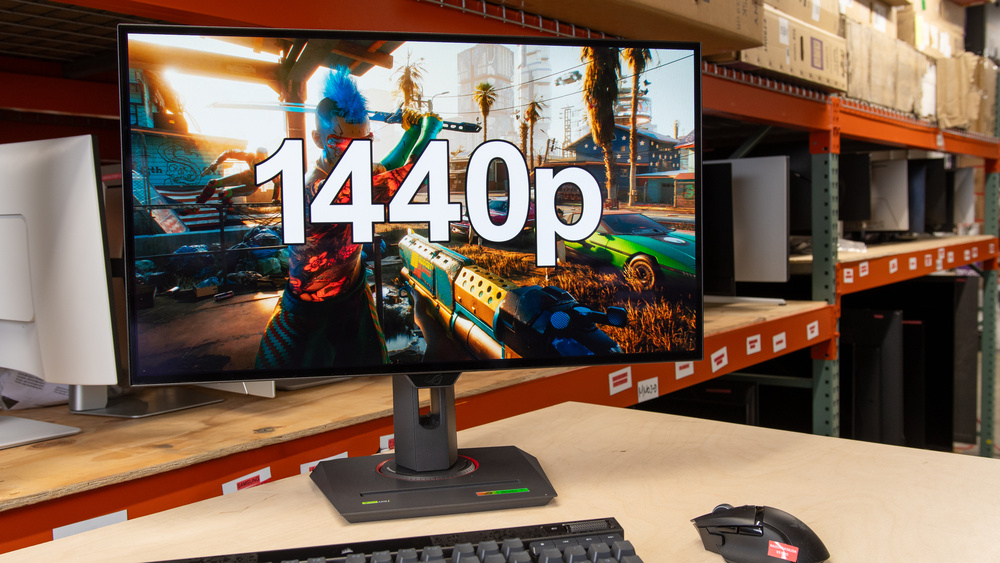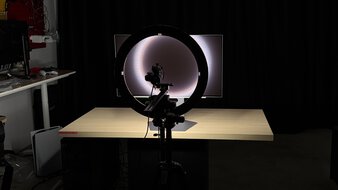There are a few advantages to getting a 1440p monitor for gaming. They strike a balance between having good enough image quality without being too taxing on your graphics card, like with a 4k monitor, allowing you to reach high frame rates. These monitors are available in a wide range of refresh rates, even up to 480Hz, so they're great for almost any type of gamer, and even current-gen gaming consoles, like the Nintendo Switch 2, PS5, PS5 Pro, and Xbox Series X|S, support 1440p signals.
When looking for a 1440p gaming monitor, there are a few things to look for. Its response time is important for sharp motion handling, and which VRR format it supports ensures compatibility with your graphics card, but most monitors work with any type of graphics card. Low input lag also produces a responsive feel, but most monitors have low input lag anyway. The majority of 1440p monitors are available with a 27- or 32-inch screen, but choosing the right size is a personal preference.
We've bought and tested more than 370 monitors, and below are our recommendations for the best 1440p gaming monitors. Also, see our recommendations for the best 1440p 144Hz monitors, the best 1440p monitors, and if you prefer a higher resolution, the best 4k gaming monitors. For more than just a monitor, check out the best gaming laptops and the best gaming headsets.
Quick Look






Looking to save on your next monitor? We've got you covered! Check out our Early Black Friday 2025 Deals article to see what's worthwhile this year.
-
Best 1440p Gaming Monitor
 PC Gaming9.2Response Time9.9HDR Picture8.9SDR Picture9.9Console Gaming9.0Brightness6.7Size27"Pixel TypeOLEDMax Refresh Rate480 HzSee all our test resultsNative Resolution2560 x 1440
PC Gaming9.2Response Time9.9HDR Picture8.9SDR Picture9.9Console Gaming9.0Brightness6.7Size27"Pixel TypeOLEDMax Refresh Rate480 HzSee all our test resultsNative Resolution2560 x 1440The best 1440p gaming monitor we've tested is the LG 27GX790A-B. It's a high-end OLED that features a fast 480Hz refresh rate. This makes it a great choice even for competitive gamers who crave high frame rates, as it offers a smooth and responsive feel. It has a near-instantaneous response time at any refresh rate, so fast-moving objects look sharp, and it supports all common VRR formats to reduce screen tearing. It even has features you'd expect in a premium gaming monitor, like HDMI and DisplayPort 2.1 bandwidth to make full use of modern graphics cards and gaming consoles.
Besides its high-end gaming performance, it also delivers fantastic picture quality. Its OLED panel displays deep and inky blacks in dark rooms without any haloing around bright objects. It also displays a wide range of colors and makes small highlights stand out, but it's not bright enough to fight intense glare in a really well-lit room. You can check out the similar ASUS ROG Swift OLED PG27AQDP if you want something brighter, particularly in SDR, but it costs more than the LG.
-
Best Upper Mid-Range 1440p Gaming Monitor
 PC Gaming9.2Response Time9.8HDR Picture9.5SDR Picture10Console Gaming9.1Brightness7.2Size27"Pixel TypeQD-OLEDMax Refresh Rate360 HzSee all our test resultsNative Resolution2560 x 1440
PC Gaming9.2Response Time9.8HDR Picture9.5SDR Picture10Console Gaming9.1Brightness7.2Size27"Pixel TypeQD-OLEDMax Refresh Rate360 HzSee all our test resultsNative Resolution2560 x 1440If you don't need the high refresh rate of the LG 27GX790A-B and prefer something less expensive, then check out the ASUS ROG Strix OLED XG27ACDNG instead. It has a lower 360Hz refresh rate than the LG, so it doesn't offer the same smooth feel at high frame rates, and it lacks DisplayPort 2.1 bandwidth, so it can't make full use of high-end, modern graphics cards. That said, it's still a fantastic gaming monitor that also has sharp motion at any refresh rate, and it even has a black frame insertion (BFI) feature to reduce persistence blur. You can use it with 120Hz or 180Hz signals, but not at the same time as VRR.
It's actually an upgrade in terms of picture quality over the LG because its QD-OLED panel displays more vivid colors. This is great if you play games in HDR, and combined with its deep, inky blacks and bright highlights, it delivers a punchy and vivid HDR experience. That said, you need to use the monitor in a dark room to get the best picture quality, as the black levels rise in bright rooms, making them look purple.
-
Best Mid-Range 1440p Gaming Monitor
 PC Gaming9.0Response Time9.9HDR Picture9.0SDR Picture9.9Console Gaming8.3Brightness7.5Size27"Pixel TypeOLEDMax Refresh Rate240 HzSee all our test resultsNative Resolution2560 x 1440
PC Gaming9.0Response Time9.9HDR Picture9.0SDR Picture9.9Console Gaming8.3Brightness7.5Size27"Pixel TypeOLEDMax Refresh Rate240 HzSee all our test resultsNative Resolution2560 x 1440If the ASUS ROG Strix OLED XG27ACDNG is out of your price range or you like to game in a brighter room, check out the ASUS ROG Strix OLED XG27AQDMG. You can often find it for less than the XG27ACDNG, especially when this monitor is on sale. It offers the same near-instantaneous response time as the XG27ACDNG, and motion is sharp, though it has a lower 240Hz refresh rate, so it's not quite as smooth and responsive. It also displays a wide range of colors, but they aren't as vivid as on the XG27ACDNG. It lacks the HDMI 2.1 bandwidth commonly found in modern consoles and graphics cards, which is a downside of getting this over the XG27ACDNG.
It has a few advantages over the XG27ACDNG, though, like if you want to use it in a well-lit room. Its black levels don't rise as much as on the QD-OLED panel of the XG27ACDNG, so it displays those deep and inky blacks that OLEDs are known for in any environment. It's also brighter than most OLEDs, so it fights some glare well, but its glossy coating has strong reflections if you place it opposite a sunny window.
-
Best Budget 1440p Gaming Monitor
 PC Gaming8.2Response Time8.5HDR Picture8.0SDR Picture8.2Console Gaming7.4Brightness8.3Size27"Pixel TypeVAMax Refresh Rate180 HzSee all our test resultsNative Resolution2560 x 1440
PC Gaming8.2Response Time8.5HDR Picture8.0SDR Picture8.2Console Gaming7.4Brightness8.3Size27"Pixel TypeVAMax Refresh Rate180 HzSee all our test resultsNative Resolution2560 x 1440If you're on a budget, you can get some budget-friendly 1440p monitors, like the AOC Q27G3XMN. It has a lower 180Hz refresh rate than the ASUS ROG Strix OLED XG27AQDMG, and while it doesn't have the same outstanding picture quality with perfect blacks as the ASUS either, its picture quality is still better than most entry-level monitors. This is because it has Mini LED backlighting with a good local dimming feature that helps it display deep blacks next to bright highlights, with minimal haloing around bright objects. It even gets brighter than the ASUS, making it better to use in a bright room.
Although it doesn't have the same sharp motion as the ASUS either, it still has a fast enough response time to ensure there isn't much blur trail behind fast-moving objects. However, its response time is slower with some transitions, leading to black smearing with dark objects. Another option is the AOC Q27G40XMN, which is similar to this monitor and is sold at Best Buy in the US. It gets brighter and has better local dimming performance, but its motion handling isn't quite as good as the Q27G3XMN.
-
Best Cheap 1440p Gaming Monitor
 PC Gaming6.9Response Time7.4HDR Picture4.9SDR Picture5.8Console Gaming6.1Brightness7.1Size27"Pixel TypeIPSMax Refresh Rate170 HzSee all our test resultsNative Resolution2560 x 1440
PC Gaming6.9Response Time7.4HDR Picture4.9SDR Picture5.8Console Gaming6.1Brightness7.1Size27"Pixel TypeIPSMax Refresh Rate170 HzSee all our test resultsNative Resolution2560 x 1440If you need a basic 1440p gaming monitor that you can get for cheap, check out the MSI G274QPF-QD. It's a 27-inch monitor like the AOC Q27G3XMN, with the biggest downside being that it has worse picture quality. It doesn't have Mini LED backlighting or even a local dimming feature, so blacks look gray, and it fails to make highlights pop in HDR. This means it's a bad choice for gaming in HDR, but this is what you have to expect at this price point. It's still fine if you want to use it in a well-lit room, though, as it gets bright enough to fight some glare.
It's a good gaming monitor with a 170Hz refresh rate, similar to the AOC. It has decent motion handling across its refresh rate range, and while there's some blur behind fast-moving objects, it at least doesn't have black smearing like on the AOC. It also has a wider viewing angle than the AOC, which is helpful to know if you want to game with a friend sitting next to you.
Notable Mentions
-
Sony INZONE M10S:
The Sony INZONE M10S is a top-of-the-line 1440p gaming monitor with a 480Hz refresh rate, competing with the LG 27GX790A-B. It performs similarly to the LG, but it also costs more than the LG.
See our review -
LG 27GS95QE-B:
The LG 27GS95QE-B is a competitor to the ASUS ROG Strix OLED XG27AQDMG with nearly the same specs. It performs similarly in terms of gaming, but it doesn't get as bright as the ASUS. It's worth considering if you can find it for less, though.
See our review -
Gigabyte AORUS FO27Q3:
The Gigabyte AORUS FO27Q3 is a high-end monitor that competes with the ASUS ROG Strix OLED XG27ACDNG. It performs similarly and has many of the same features, so it may be worth getting if you can find it for less, but it's also harder to find at times.
See our review -
ASUS ROG Strix XG27ACS:
The ASUS ROG Strix XG27ACS is an entry-level 1440p gaming monitor that has better motion handling than the MSI G274QPF-QD. However, it costs more, so it may be out of your budget.
See our review
Recent Updates
Nov 07, 2025:
We added the LG 27GX790A-B as the best overall, as it has a higher refresh rate than the ASUS ROG Strix OLED XG27ACDNG, which we renamed to the 'Best Upper Mid-Range 1440p Gaming Monitor.' We also renamed the ASUS ROG Strix OLED XG27AQDMG to the 'Best Mid-Range 1440p Gaming Monitor' and added the MSI G274QPF-QD as the 'Best Cheap 1440p Gaming Monitor.' Lastly, we added the ASUS ROG Strix XG27ACS to the Notable Mentions.
Jun 26, 2025:
Replaced the MSI MPG 271QRX QD-OLED with the ASUS ROG Strix OLED XG27ACDNG, as the MSI is hard to find. Also, mentioned the AOC Q27G40XMN in the Best Budget section.
Mar 27, 2025:
We removed the LG 27GP850-B/27GP83B-B because it's hard to find. We also replaced the ASUS ROG Swift OLED PG27AQDP with the Sony INZONE M10S in the Notable Mentions.
Feb 19, 2025:
We introduced a new format to the article and updated the text to reflect these changes. Additionally, we removed the ASUS ROG Swift PG279QM and the LG 27GR83Q-B, as they don't provide as much value as the AOC Q27G3XMN. We also removed the ASUS ROG Strix XG27ACS as a Notable Mention.
Dec 11, 2024:
We replaced the Gigabyte AORUS FO27Q3 with the MSI MPG 271QRX QD-OLED because the MSI is easier to find and for consistency with other recommendations. We also added the ASUS ROG Swift PG279QM as the 'Best Mid-Range Monitor' and renamed the LG 27GR83Q-B to the 'Best Lower Mid-Range Monitor' to give another option. In the Notable Mentions, we removed the Samsung Odyssey OLED G6/G60SD S27DG60 and the Gigabyte M27Q X and added the ASUS ROG Swift OLED PG27AQDP, ASUS ROG Strix XG27ACS, MSI MPG 341CQPX QD-OLED, and the FO27Q3 based on the changes to the article.
All Reviews
Our recommendations are based on what we think are the best 1440p gaming monitors currently available. They're adapted to be valid for most people. The rating is based on our review, factoring in price and feedback from our visitors.
If you'd prefer to make your own decision, here is the list of all of our 1440p monitor reviews. Be careful not to get too caught up in the details. Most monitors are good enough to please most people, and the things we fault monitors on are often not noticeable unless you really look for them.















